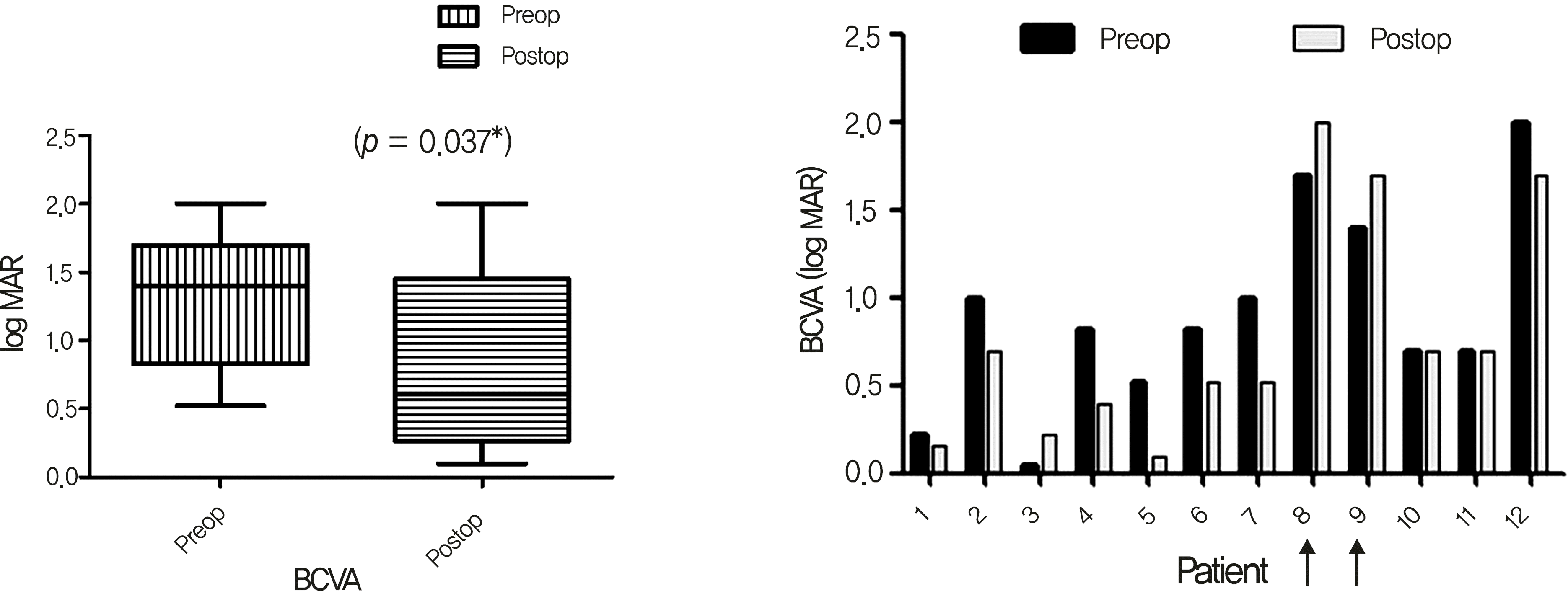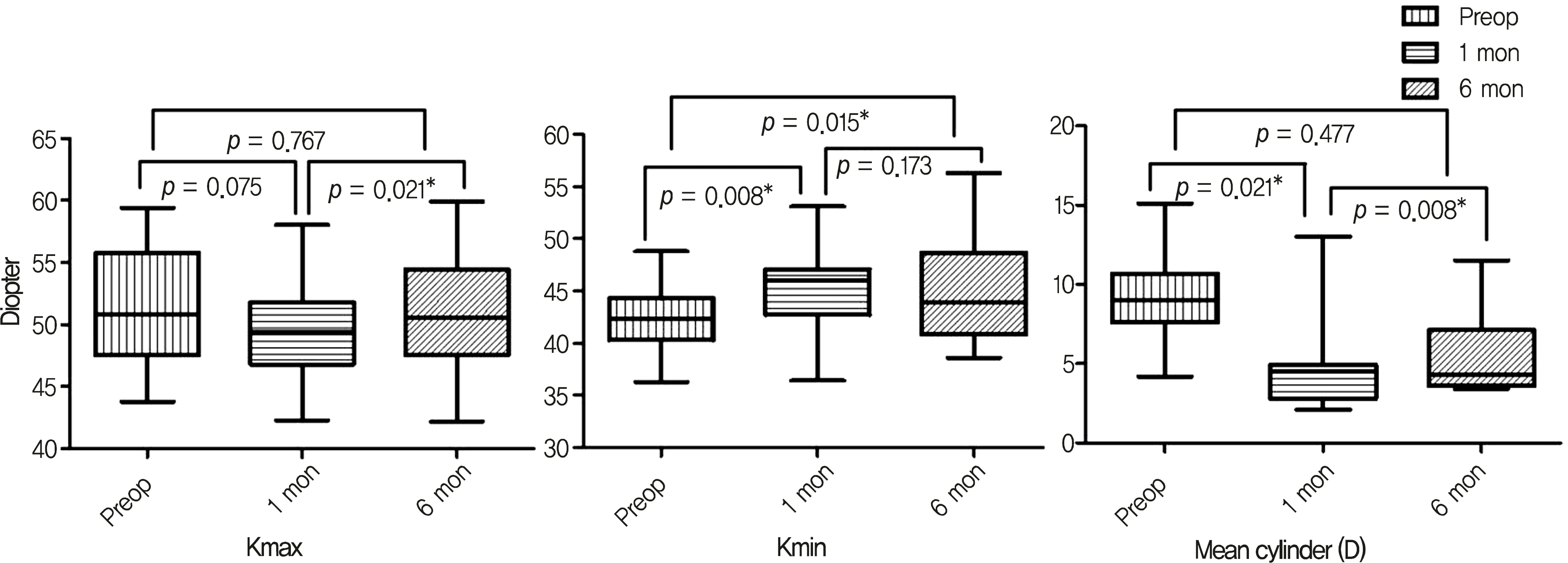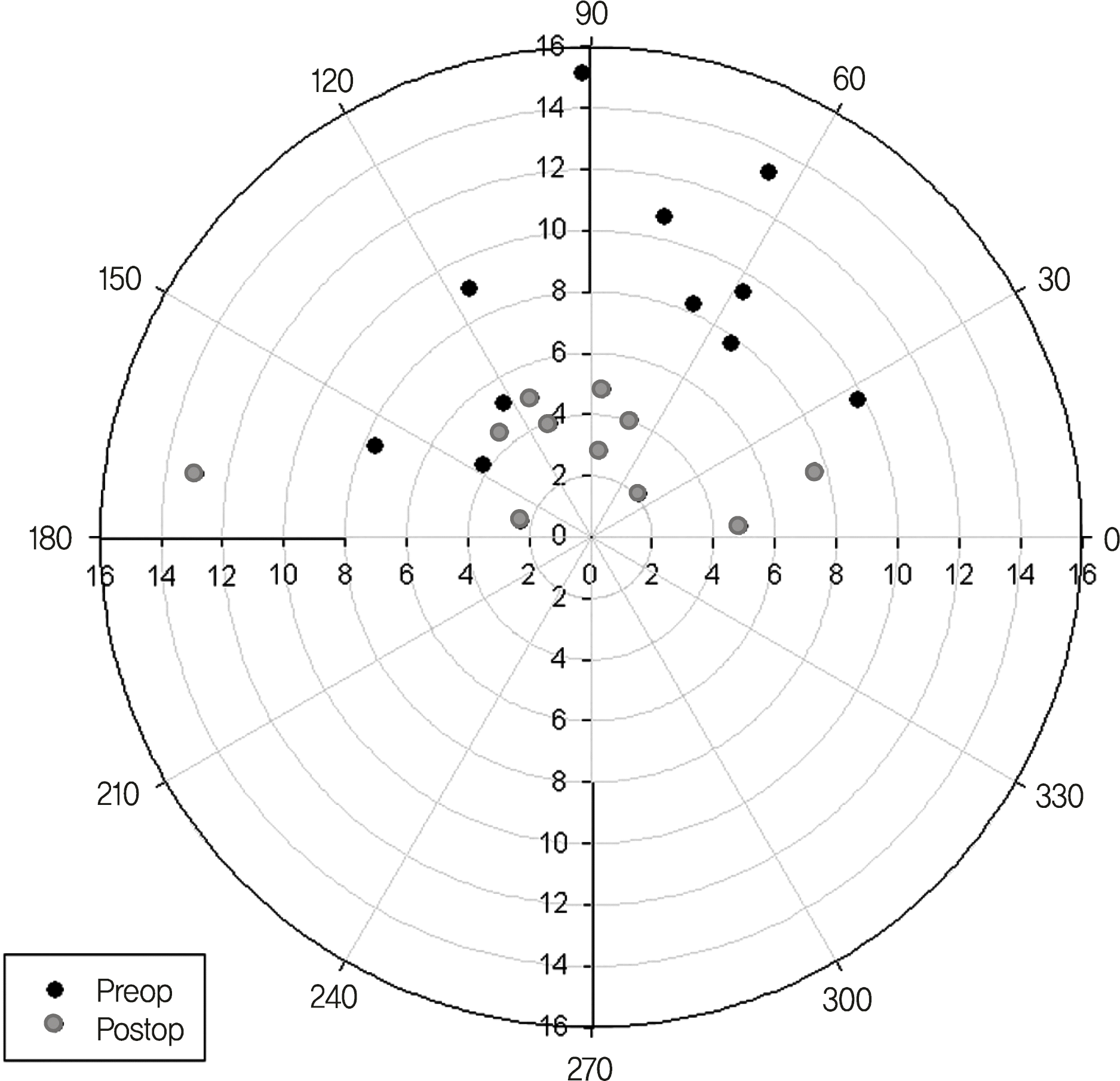Abstract
Purpose
To investigate the short-term effect of limbal relaxing incisions accompanied by compression sutures on post-operative astigmatism in penetrating keratoplasty.
Methods
The medical records of patients who underwent penetrating keratoplasty, were followed-up for at least 18 months and had residual astigmatism greater than 4.0 diopters (D), were retrospectively analyzed. The patients had paired limbal relaxing incisions on the steep axis and compression sutures on the flat axis. The paired limbal relaxing incision was done for 2 clock hours each with a depth of 85% of the corneal thickness, and the compression sutures with an average of 3.2 bites were added with a Troutman operating keratometer guide. The visual acuities, corneal astigmatism and complications were evaluated at 1 month and 6 months.
Results
At 1 month after the surgery, the best corrected visual acuities (log MAR) improved from 0.840 to 0.674 (p = 0.037) except for 1 patient with immediate postoperative rejection and another patient with a preexisting cataract. The mean corneal astigmatism was reduced from 9.118 ± 3.158 D to 4.982 ± 3.063 D (p = 0.021). At 6 months after the surgery, the mean corneal astigmatism increased to 5.489 ± 2.670 D (p = 0.008), and the effect of surgery became statistically insignificant (p = 0.477).
References
1. Murta JN, Amaro L, Tavares C, Mira JB. Astigmatism after penetrating keratoplasty. Role of the suture technique. Doc Ophthalmol. 1994; 87:331–6.
2. Williams KA, Roder D, Esterman A, et al. Factors predictive of corneal graft survival. Report from the Australian Corneal Graft Registry. Ophthalmology. 1992; 99:403–14.
3. Busin M, Monks T, al-Nawaiseh I. Different suturing techniques variously affect the regularity of postkeratoplasty astigmatism. Ophthalmology. 1998; 105:1200–5.

4. Eggink FA, Nuijts RM. A new technique for rigid gas permeable contact lens fitting following penetrating keratoplasty. Acta Ophthalmol Scand. 2001; 79:245–50.

5. Kuryan J, Channa P. Refractive surgery after corneal transplant. Curr Opin Ophthalmol. 2010; 21:259–64.

6. Wilkins MR, Mehta JS, Larkin DF. Standardized arcuate keratotomy for postkeratoplasty astigmatism. J Cataract Refract Surg. 2005; 31:297–301.

7. Koay PY, McGhee CN, Crawford GJ. Effect of a standard paired arcuate incision and augmentation sutures on postkeratoplasty astigmatism. J Cataract Refract Surg. 2000; 26:553–61.

8. Javadi MA, Feizi S, Yazdani S, et al. Outcomes of augmented relaxing incisions for postpenetrating keratoplasty astigmatism in keratoconus. Cornea. 2009; 28:280–4.

9. Claesson M, Armitage WJ. Astigmatism and the impact of relaxing incisions after penetrating keratoplasty. J Refract Surg. 2007; 23:284–9.

10. Bochmann F, Schipper I. Correction of postkeratoplasty astigmatism with keratotomies in the host cornea. J Cataract Refract Surg. 2006; 32:923–8.

11. Alessio G, Boscia F, La Tegola MG, Sborgia C. Corneal interactive programmed topographic ablation customized photorefractive keratectomy for correction of postkeratoplasty astigmatism. Ophthalmology. 2001; 108:2029–37.

12. Lazzaro DR, Haight DH, Belmont SC, et al. Excimer laser keratectomy for astigmatism occurring after penetrating keratoplasty. Ophthalmology. 1996; 103:458–64.
13. Kwitko S, Marinho DR, Rymer S, Ramos Filho S. Laser in situ keratomileusis after penetrating keratoplasty. J Cataract Refract Surg. 2001; 27:374–9.

14. Webber SK, Lawless MA, Sutton GL, Rogers CM. LASIK for post penetrating keratoplasty astigmatism and myopia. Br J Ophthalmol. 1999; 83:1013–8.

15. Lee HS, Kim MS. Factors related to the correction of astigmatism by LASIK after penetrating keratoplasty. J Refract Surg. 2010; 26:960–5.

16. Kaye SB, Campbell SH, Davey K, Patterson A. A method for assessing the accuracy of surgical technique in the correction of astigmatism. Br J Ophthalmol. 1992; 76:738–40.

17. Chang DH, Hardten DR. Refractive surgery after corneal transplantation. Curr Opin Ophthalmol. 2005; 16:251–5.

18. Nubile M, Carpineto P, Lanzini M, et al. Femtosecond laser arcuate keratotomy for the correction of high astigmatism after keratoplasty. Ophthalmology. 2009; 116:1083–92.

19. Vajpayee RB, Sharma N, Sinha R, et al. Laser in-situ keratomileusis after penetrating keratoplasty. Surv Ophthalmol. 2003; 48:503–14.

20. Nassaralla BR, Nassaralla JJ. Laser in situ keratomileusis after penetrating keratoplasty. J Refract Surg. 2000; 16:431–7.

21. Ranchod TM, McLeod SD. Wound dehiscence in a patient with keratoconus after penetrating keratoplasty and LASIK. Arch Ophthalmol. 2004; 122:920–1.
Figure 1.
Preoperative and postoperative photographs and topographs. These figures show typical topographic changes after limbal relaxing incision and compression sutures. The figures on the left are preoperative photographs and topographs with a simulated keratometry of 7.6 diopters. Paired relaxing incisions (arrows) were done at the steep axis on the limbus, and 4 compression sutures (arrow heads) were added at the flat axis on the junction between graft and host. The figures on the right are postoperative photographs and topographs with a simulated keratometry of 2.3 diopters.

Figure 2.
Improvement in BCVA after limbal relaxing incision and compression sutures. Best corrected visual acuities (BCVA, log MAR) improved from 0.840 to 0.674, and got worse in cases of rejection (patient 8, arrow) and cataract progression (patient 9, arrow).

Figure 3.
Mean topographic changes in Kmax, Kmin and topographic astigmatism. At 1 month after the surgery, mean corneal power of steep axis (Kmax) was reduced from 51.3 ± 4.8 D to 49.8 ± 4.1 D (p = 0.075) and mean corneal power of flat axis (Kmin) increased from 42.1 ± 3.1 D to 44.2 ± 5.2 D (p = 0.008). As a result mean corneal astigmatism was reduced from 9.118 ± 3.158 D to 4.982 ± 3.063 D (p = 0.021). At 6 months after the surgery, mean corneal astigmatism increased to 5.489 ± 2.670 D (p = 0.008), and the effect of surgery became statistically insignificant (p = 0.477).

Figure 4.
Vector analysis of mean topographic astigmatism. This polar plot demonstrates the magnitude and the axis of mean topographic astigmatism. Each concentric ring represents 2.0 diopters of change. Vector analysis of mean topographic astigmatism shows changes of 7.9 ± 5.4 diopters. Gray dots (postoperative astigmatism) are closer to the center compared with black dots (preoperative astigmatism).

Figure 5.
Further follow up of corneal astigmatism. Mean topographic astigmatism increases in some patients after the short-term effect of limbal relaxing incision and compression sutures.

Table 1.
Patients demographics and pre-operative data
| | Sex/Age (yr) | PKP indication | Time interval (mon)* | Preop BCVA (log MAR) | Preop mean cylinder (D) |
|---|---|---|---|---|---|
| 1 | F/66 | Limbal insufficiency | 34 | 0.20 | 9.8 |
| 2 | M/55 | Mooren's ulcer | 117 | 1.00 | 15.1 |
| 3 | M/32 | Keratoconus | 48 | 0.05 | 5.2 |
| 4 | F/35 | SCL related pseudomonas keratitis | 69 | 0.80 | 9.0 |
| 5 | F/37 | Chronic rejection | 21 | 0.50 | 7.6 |
| 6 | F/75 | Herpes stromal keratitis | 25 | 0.80 | 10.7 |
| 7 | F/80 | Pseudophakic bullous KP | 163 | 1.00 | 9.4 |
| 8 | F/71 | Bullous KP | 19 | 1.70 | 10.4 |
| 9 | M/69 | Herpetic keratitis | 22 | 1.40 | 7.8 |
| 10 | M/49 | FB related corneal opacity | 21 | 0.70 | 8.3 |
| 11 | M/76 | Bullous KP | 25 | 0.70 | 4.2 |
| 12 | F/63 | Unknown keratitis | 125 | 2.00 | 13.2 |
Table 2.
Comparison with previous results of astigmatic surgery following PKP
| Studies (year of publish) | Technique | Intraop Kerato | N | PKP to Incision (mon) | FU (mon) | Preop Astig | Postop Astig | Reduction | Changes in BCVA (log MAR) |
|---|---|---|---|---|---|---|---|---|---|
| Wilkins et al.(2005) | RI* only on graft | X | 20 | 40.8 | 3 | 10.99 | 3.33 | 7.66 (69.7%) | NA‡ |
| Koay et al.(2000) | RI + S† on junction | X | 34 | NA | 12 | 9.14 | 3.59 | 5.55 (60.7%) | 0.49 to 0.26 |
| Javadi et al.(2009) | RI + S on junction | O | 77 | 61.5 | 40.8 | 7.9 | 4.5 | 3.4 (43.0%)5.9 (Vector) | 0.31 to 0.18 |
| Claesson et al.(2007) | RI only on junctiion | X | 131 | >24 | >2 | 8.40 | 3.80 | 4.60 (54.8%)7.9 (Vector) | NA |
| Bochmann et al.(2006) | RI ± S on limbus | O | 11 | 15 | 18.5 | 6.1 | 3.3 | 2.8 (46%) | 0.5 to 0.2 |
| Current study | RI + S on limbus | O | 11 | 57 | 1 | 9.12 | 4.98 | 4.14 (45%)7.97 (Vector) | 0.84 to 0.67 |




 PDF
PDF ePub
ePub Citation
Citation Print
Print


 XML Download
XML Download